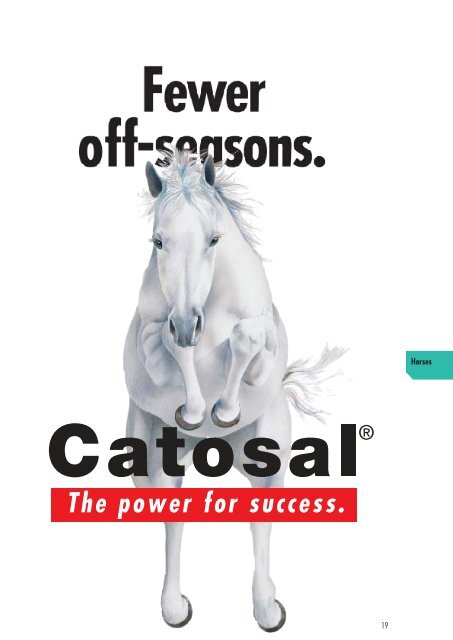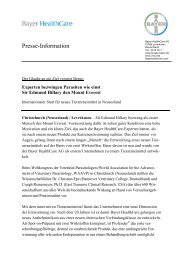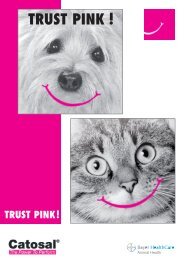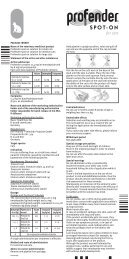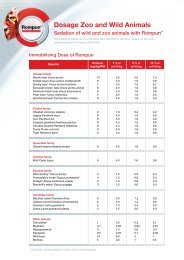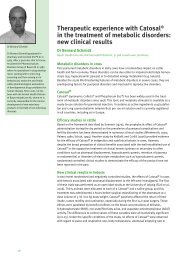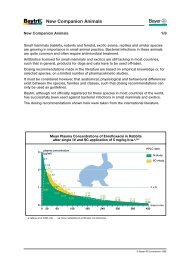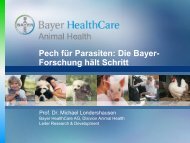612658 Catosal 3. 9.´96 - Bayer Animal Health
612658 Catosal 3. 9.´96 - Bayer Animal Health
612658 Catosal 3. 9.´96 - Bayer Animal Health
You also want an ePaper? Increase the reach of your titles
YUMPU automatically turns print PDFs into web optimized ePapers that Google loves.
19<br />
Horses
<strong>Catosal</strong> is the key to<br />
support specific<br />
therapy of diseases<br />
<strong>Catosal</strong> acts as a safe and<br />
reliable stabilizing agent<br />
and beneficial metabolic<br />
stimulant. Depending on<br />
the indication, often in<br />
conjunction with antibiotics, <strong>Catosal</strong> is recommended<br />
as adjunctive therapy in diseases where the<br />
immune system is compromised by viral and bacterial<br />
agents as well as a backup in sterility treatment<br />
(Cockram et al., 1981; Rösch et al., 1992; Schulze,<br />
1968).<br />
In cases with metabolic disturbances, which are<br />
commonly present in a wide range of diseases,<br />
<strong>Catosal</strong> has also proven its worth as a metabolic stimulant.<br />
The successful supportive use of <strong>Catosal</strong><br />
also in cases of uterine prolapse and grass tetany<br />
was reported by Cran (1975) and Rüggeberg<br />
(1980), respectively.<br />
The impact of <strong>Catosal</strong> on recovery is<br />
striking<br />
Exertion-induced phoshorus and vitamin B 12 deficiency<br />
causes reduced serum phosphate levels<br />
and/or macrocytic normocromic anaemia. Although<br />
CATOSAL SMOOTHES<br />
THE NATURAL<br />
ROUTE TO RESTORE<br />
HEALTH.<br />
horses are less vulnerable<br />
to phosphorus deficiency<br />
than cattle, this can still<br />
contribute to skeletal damage<br />
and certain forms of<br />
lameness (Kaneko, 1980).<br />
Horses face phosphorus<br />
loss not only via faeces and<br />
urine but also sweat. This further increases phosphorus<br />
requirements during exertion (Schryver and<br />
Hintz, 1981). As demonstrated by Coppo and<br />
Gapel (1987) in thoroughbreds suffering from<br />
hypophosphataemia and/or macrocytic anaemia,<br />
<strong>Catosal</strong> treatment rapidly normalizes blood phosphorus<br />
levels, while steadily normalizing and<br />
maintaining haematological parameters. Improvement<br />
of the general clinical condition was another<br />
useful treatment effect of <strong>Catosal</strong>.<br />
The positive therapeutic impact of <strong>Catosal</strong> on haematologic<br />
values was also shown in horses suffering<br />
from over-exertion. The steady decrease in haematopoetic<br />
function, caused by prolonged physical<br />
stress over time, was effectively counteracted by<br />
the active ingredients of <strong>Catosal</strong>. In this case, the<br />
best indicator of improvement proved to be Mean<br />
Corpuscular Volume (Marbach, 1978).<br />
20
Normalization of parameters in horses with hypophosphataemia/macrocytic anaemia after administration of <strong>Catosal</strong>.<br />
(Source: Coppo and Gapel, 1987)<br />
Reference values in %<br />
130<br />
120<br />
110<br />
100<br />
90<br />
80<br />
70<br />
60<br />
50<br />
40<br />
30<br />
20<br />
10<br />
0<br />
P (mg/dl)<br />
Haemotocrit (%) Haemoglobin (g/dl) Erythrocytes (10 6 x mm 3 )<br />
Day 0<br />
Day 10/30<br />
= before commencement of treatment<br />
= 10/30 days after commencement of treatment<br />
Day 0 Day 10 Day 30<br />
Development of MCV and TPP in horses suffering from exhaustion, after treatment with <strong>Catosal</strong>. (Source: Marbach, 1978)<br />
41.0<br />
40.5<br />
6.50<br />
40.0<br />
6.45<br />
μm 3<br />
39.5<br />
39.0<br />
38.5<br />
g/100 ml<br />
6.40<br />
6.35<br />
6.30<br />
Horses<br />
38.0<br />
6.25<br />
37.5<br />
6.20<br />
MCV (mean cell volume)<br />
TPP (total plasma protein)<br />
0<br />
0<br />
Before treatment<br />
After treatment<br />
Indication<br />
Dosage (i.v. or s.c./i.m.)<br />
Recovering from exhaustion<br />
7,5-10 ml/100kg/every<br />
2-3 days, for 14 days<br />
Convalescence<br />
15-20 ml/animal/day for 10 days<br />
21
REFERENCES<br />
COCKRAM, F.; WEBB, R.; MOEN, D. (1981):<br />
Isolation of Bordetella bronchiseptica from a horse.<br />
Austr. Vet. J. 57, 7, 348<br />
COPPO, J.; GAPEL, E. (1987):<br />
Ergebnisse der Verabreichung von <strong>Catosal</strong> an Sportpferde in Argentinien.<br />
Vet. Med. Nachr. 1, 33-35,<br />
CRAN, H. (1975):<br />
Uterine prolapse in the mare.<br />
Vet. Rec. 97, 1, 19<br />
KANEKO, J. J. (1980) nach COPPO und GAPEL (1987):<br />
Ergebnisse der Verabreichung von <strong>Catosal</strong> an Sportpferde in Argentinien.<br />
Vet. Med. Nachr. 1, 33-35<br />
MARBACH, W. (1978):<br />
Hämatologische Parameter zur Kondition von Rennpferden und die Wirkung<br />
von Coforta/<strong>Catosal</strong> auf das erschöpfte Pferd.<br />
Vet. Med. Nachr. 1, 82-92<br />
MARBACH, W. (1980):<br />
Alkalische Phosphatase (AP) und Aspartataminotransferase (AST) des<br />
Blutplasmas als Parameter der Kondition von Rennpferden und die<br />
Wirkung von Coforta/<strong>Catosal</strong> auf diese Enzyme.<br />
Vet. Med. Nachr. 1, 63-69<br />
ROESCH, X.; ROESCH, B.; ENGEL, M. (1992):<br />
Verlaufsbericht einer equinen Herpesinfektion mit EHV-1- und EHV-4-Viren.<br />
Prakt. Tierarzt 73, 11, 1050-1056<br />
RÜGGEBERG, K. (1980):<br />
Notizen aus der Praxis: Weidetetanie bei einer Fohlenstute.<br />
Tierärztl. Umschau 35, 7, 467<br />
SCHRYVER, H. F.; HINTZ, H. F. (1981) nach COPPO und GAPEL (1987):<br />
Ergebnisse der Verabreichung von <strong>Catosal</strong> an Sportpferde in Argentinien.<br />
Vet. Med. Nachr. 1, 33-35<br />
SCHULZE, G. (1968):<br />
Kollegen berichten ... über praktische Erfahrungen in der Sterilitätsbehandlung<br />
bei Stuten mit Tardomyocel-L-Suspension.<br />
Vet. Med. Nachr. 2, 171-172<br />
22


